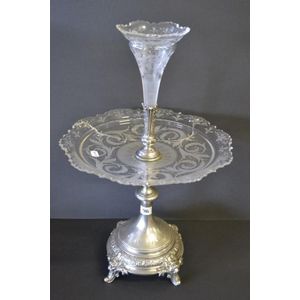Victorian Deceptive Glass with Conical Bowl and Swollen Knop
You must be a subscriber, and be logged in to view price and dealer details.
Subscribe Now to view actual auction price for this item
When you subscribe, you have the option of setting the currency in which to display prices to $Au, $US, $NZ or Stg.
- Circa - A Latin term meaning 'about', often used in the antique trade to give an approximate date for the piece, usually considered to be five years on either side of the circa year. Thus, circa 1900 means the piece was made about 1900, probably between 1895 and 1905. The expression is sometimes abbreviated to c.1900.
- Knop (glass) - In Georgian glassware, the knop is a bulbous protrusion, usually midway up the stem of the glass. It may be included singly or in groups, and may be hollow or solid. There are many styles of knop including basal, baluster, bell, acorn, cone, flattened, melon and mushroom.
- Victorian Period - The Victorian period of furniture and decorative arts design covers the reign of Queen Victoria from 1837 to 1901. There was not one dominant style of furniture in the Victorian period. Designers used and modified many historical styles such as Gothic, Tudor, Elizabethan, English Rococo, Neoclassical and others, although use of some styles, such as English Rococo and Gothic tended to dominate the furniture manufacture of the period.
The Victorian period was preceded by the Regency and William IV periods, and followed by the Edwardian period, named for Edward VII (1841 ? 1910) who was King of the United Kingdom and the British Dominions and Emperor of India for the brief period from 1901 until his death in 1910. - Pontil Mark - A pontil mark, also known as a pontil scar, is a distinctive mark or scar found on the base of certain types of glass. It is a remnant of the glassblowing process and is particularly associated with handcrafted items made prior to the widespread use of automated manufacturing.
The pontil mark is created during the final stages of production. After the glassblower has shaped and formed the glass object, it is removed from the blowing iron. At this point, the glass object is often attached to a solid rod called a pontil rod or punty for further shaping, finishing, or attaching additional components. The attachment point is typically at the base of the object.
Once the glass item is complete, it is detached from the pontil rod, leaving behind a mark or scar on the base. This mark can take various forms, such as a rough or irregular surface, a concave or slightly recessed area, or a small circular scar. The presence of a pontil mark indicates that the item was handcrafted rather than mass-produced.
Collectors and historians often use pontil marks as clues to determine the age, authenticity, and production methods of glass or ceramic pieces. Different types of pontil marks may suggest different techniques used in the production process. For example, an open pontil mark is one where the scar is left as an exposed, roughened area, while a closed pontil mark occurs when the scar is smoothed or covered in some way. It's important to note that not all handcrafted glass items have pontil marks, as some artisans developed alternative methods for finishing their work. In Edwardian times the pontil mark was oftern ground off leaving a concave circle in the centre of the base of the object.
The use of pontil marks diminished with the advent of industrialization and automated manufacturing processes in the 19th and 20th centuries.
This item has been included into following indexes:
Visually similar items

A fine set of antique French crystal wine goblets, early 20th century, with slice cuts to the bowls, faceted baluster stems with trapped bubble motifs and spreading hexagonal bases, height 15.5 cm

Antique Continental silver and etched glass table centre piece (glass repaired)

A George II plain stem Balustroid wine glass, circa 1740, the bell shaped bowl with a tapering stem to a conical fold over foot with a rough pontil, with various trapped bubbles and impurities including one significant 'Stone' to the bowl. Height 15.5 cm

A late Georgian bobbin stem engraved cordial glass, circa 1830, with a rose and foliage engraved trumpet bowl above a four knop bobbin stem to a conical foot, with a lightly polished pontil. Height 14.5 cm
